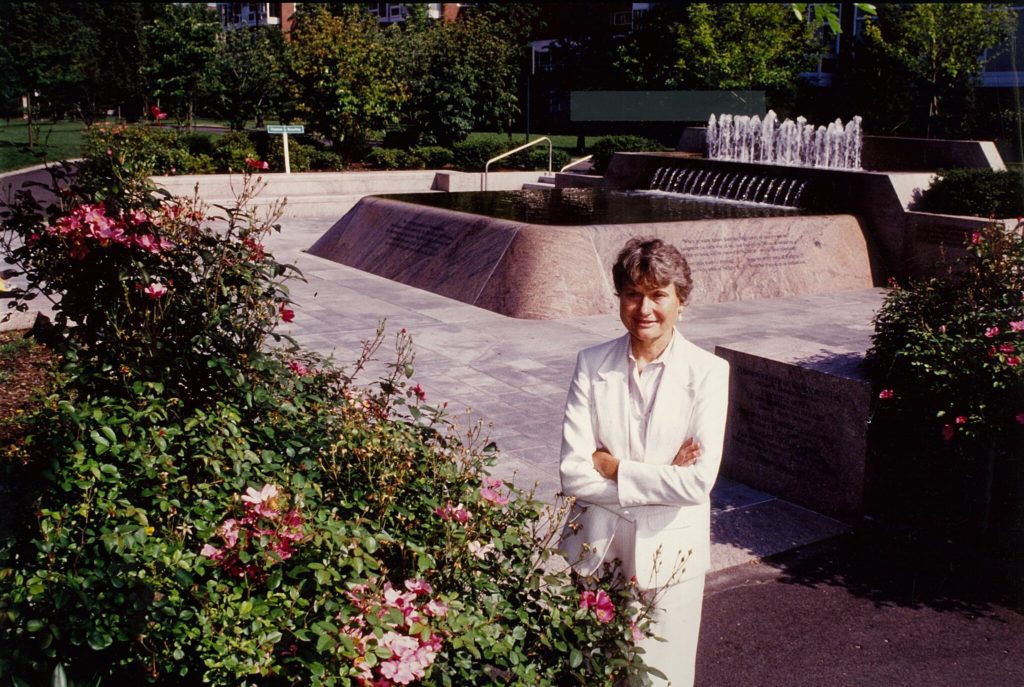
The Harvard Graduate School of Design honors Carol Johnson, FASLA (MLA ’57), leading landscape architect and GSD alumna and professor, who died on December 11, 2020, at her home in Boothbay Harbor, Maine. She was 91. Johnson enjoyed a multifaceted and pioneering career, in which she turned abandoned urban sites into majestic civic spaces, and nurtured an office that would grow into one of the country’s largest and most influential landscape architecture firms.
Carol Roxane Johnson arrived at the GSD almost organically. She was born in Elizabeth, New Jersey, on September 6, 1929, and grew up in nearby Union, New Jersey, enjoying a connection with nature from a young age. After earning an English degree at Wellesley College in 1951, she bicycled through Europe, taking in designed and wild landscapes. In the years that followed, Johnson returned to the United States and took on gigs including as a tour guide at a wax museum in Florida, then at New England Nurseries in Bedford, Massachusetts, where she lived in a shack on the grounds. There, she met a cohort of GSD landscape architecture students, who would inspire her to pursue her own design degree.
Johnson graduated from the GSD with a Master in Landscape Architecture in 1957, then took a job with the Architects Collaborative (TAC) in 1958, before opening her own firm in Cambridge in 1959. From those early days—when the office measured not much beyond a drafting table in her apartment—Carol R. Johnson & Associates grew to a staff of more than 100, taking on projects around the world. Johnson returned to the GSD to teach from 1966 to 1973. Among her honors, she became a Fellow of the American Society of Landscape Architects in 1982, and earned the American Society of Landscape Architects’ gold medal in 1998—the first woman awarded this prize.
Over her career, Johnson’s landscape work converged around themes of the civic realm, the remediation of neglect and environmental harm, and respect for contextualism. In the early 1980s, she took on Cambridge’s John F. Kennedy Park along the Charles River, transforming the five-acre site from an oil-saturated train storage yard to a welcoming public park. Johnson cited New England streams as a contextual inspiration for her design, a project she would often note as a favorite of her career. (As the New York Times observes, Johnson would sometimes offer a different answer to the favorite-project question: “My favorite project is when something gets done.”)
“Contextualism was the ruling principle behind much of Carol’s work,” says Jennifer Jones, a principal at Carol R. Johnson & Associates for over 30 years, in an interview with the New York Times. “She was respectful of the history of a place and the meaning of a place. Many designs were about healing the land.”
Among Johnson’s noteworthy projects are the Mystic River State Reservation in Massachusetts, in which she turned a toxic site into a civic space, not unlike the John F. Kennedy Park; the John Marshall Park in Washington, DC, a project Johnson won via a national competition, turning a parking-lot site into a terraced landscape; and her contributions to the United States Pavilion for Expo 67 in Montreal, a collaboration with Buckminster Fuller and others. To create the pavilion’s supersized, tree-lined geodesic dome, Johnson, according to the New York Times, “barnstormed around rural Canada in a small plane, touching down when she saw [trees] she liked and buying them outright from farmers and landowners.”
In 1972, Johnson worked as part of President Johnson’s Model Cities Program at the North Common in Lowell, Massachusetts, and later served as a member of the Treasury Department’s Commission on Small Business under President Carter. She focused a good deal of her attention on college and university campuses, including designs for Boston College, Duke University, Agnes Scott College, Harvard University, and her alma mater, Wellesley College. In the ethos of engaging design toward healing and remediation, Johnson also dedicated much of her career to public housing, most notably a trio of Greater Boston housing projects in the 1980s.
“When she was working on public housing, she listened to what the tenants wanted, not just the bureaucrats,” Jones tells the New York Times. “While historically women landscape architects had worked primarily on residential and park projects in small offices, or as sole practitioners, she really pushed open the door for acceptance of a larger, woman-owned firm doing prestigious and complex projects in the public, institutional and corporate realm.”
Today, Johnson’s firm is known as CRJA-IBI Group and has grown to include 10 principals and offices outside Boston. Johnson retired from practice in 2016 and leaves, as the Architect’s Newspaper observes, “an indelible legacy.”
Learn more about Johnson via the Cultural Landscape Foundation’s oral history project.